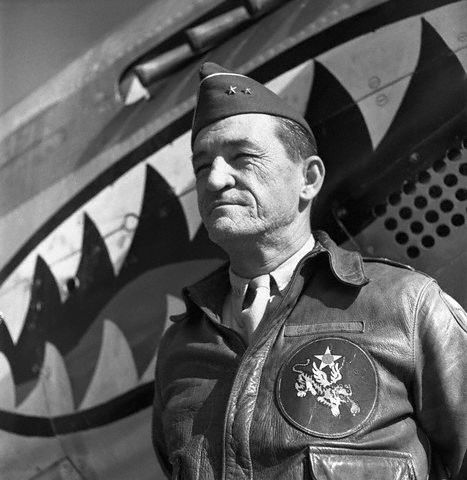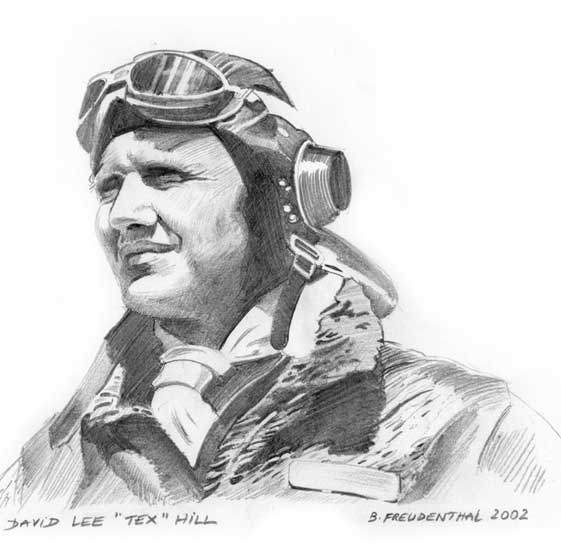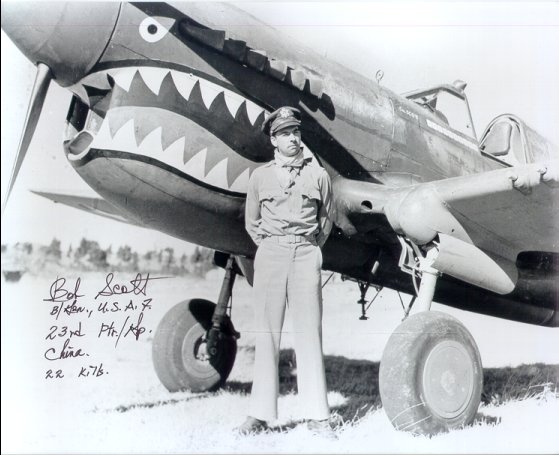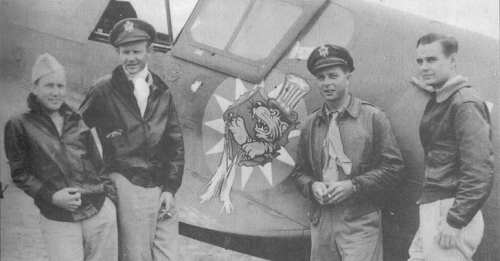| The Flying Tigers | |||
| Home Page | Airmen Index | ||
 | |||
|---|---|---|---|
| Claire Chennault | |||
|
Late in 1941, three months before the attack on Pearl Harbor, a group of young men left San Francisco in several Dutch ships bound for the Far East. They told fellow passengers they were businessmen or teachers, and some, like Gregory Boyington, were instructed to say they were clergymen.
Actually they were American pilots from the Army Air Corps, Navy, and Marines, on their way to China, to become part of a flying foreign legion called the American Volunteer Group (AVG). China had been at war with Japan for almost four years, and from the beginning, Japanese war planes had been able to bomb and strafe helpless Chinese cities at will. Finally, in desperation, China asked a retired Air Corps captain, Claire Chennault, to form a Chinese air force. Chennault probably understood the value of fighter planes as well as anyone else in the world. He believed that the fighter was the key to air power. Without such fighters, the air could not be controlled, and bombers would be at the mercy of the enemy. This was at a time when more and more air officers were beginning to believe that an armed bomber could take care of itself. |
 | |
|---|---|
| David Lee "Tex" Hill |
|
Chennault had written a book on the subject, The Role of Defensive Pursuit, but the Army would not listen to his ideas. Now in China he had a chance to test them in actual combat, and there is reason to believe that Chennault himself shot down at least thirty Japanese planes before the AVG arrived. At first he had no modern planes for his tiny command, but early in 1941 a group of Americans sent him a gift of 100 Curtiss-Wright P-40 Tomahawks. He got pilots for them by "raiding," unofficially, the American military services. Men like Bob Neale and David "Tex" Hill came to fly with him. In reality they were mercenaries, and were paid $600 a month, plus $500 for each Japanese plane they destroyed.
Chennault taught them everything he knew. He showed them the strong points of the P-40, and the weaknesses of the Zero. He repeated over and over again, "Never try to turn with a Zero. Always get above the enemy and try to hit him on the first pass. After that keep going." The Zero could not catch the P-40 in a dive. |
 | |
|---|---|
| Gregory Boyington, Flight Leader of the Adam and Eves. |
|
The nose of each Tomahawk was painted with a grinning shark's mouth, and three squadrons were formed. They were nicknamed the "Adam and Eves," the "Panda Bears" and "Hell's Angels. "
On December 19th the Japanese got the surprise of their lives. A group of their bombers were on their way to bomb Kunming Field. They were unaware that Chennault's group, soon to be known as the Flying Tigers, were now trained and ready for combat. Consequently the Japanese bombers were not escorted by fighters. Chennault dispatched several Tigers to intercept over the field, and also sent fifteen more to catch the bombers on their way back home. The trap worked. Only four Japanese planes escaped. After that, Zero fighters always accompanied the bombers, but it made no difference; Chennault had taught his Tigers well. On Christmas Day, the Japanese sent over one hundred fighters and bombers. The Hell's Angels Squadron, all eighteen of them, clawed at the massive enemy formation and destroyed thirty-three. The Flying Tigers didn't lose a plane. Of course once in a while a new man would forget Chennault's careful instructions. Gregory Boyington, Flight Leader of the Adam and Eves, found himself doing all the wrong things in his first combat. He was sure he could dog-fight the Zero. But no matter how hard he hauled back on the stick of his Tomahawk, the Zero turned inside him and each time he saw tracers whipping past his head. He finally gave up in disgust, lucky to escape with his life. Boyington learned quickly, however, and before he left the Flying Tigers he had downed six Japanese planes. At no time after that first fight did the Flying Tigers have more than fifty P-40s ready for combat. And sometimes the fitness of these few planes was doubtful. A reporter once asked Bob Neale why he hadn't made a Victory Roll over the field after a successful mission. "Confidentially," said Neale, "we can't roll 'em any more. If we tried it, they'd probably fall apart in our laps." Until it was absorbed into the Army on July 4, 1942, the American Volunteer Group set a matchless record. Officially destroying 299 enemy planes, while losing only 8 of their own pilots in combat. There is little doubt that easily twice this many Japanese aircraft were actually shot down.
July 4th was the date set for the AVG pilots to transfer into the regular Army Air Corps. They were all to become members of the 23rd Fighter Group. It was soon obvious, however, that most of the veterans of the Flying Tigers wanted either to go home, or to rejoin their original branch of the service. Boyington, for instance, reenlisted in the Marine Corps. A few, like Tex Hill, stayed on. Luckily many pilots agreed to remain for a brief time, to help the new Army fighter commander, Colonel Robert L. Scott, Jr., to get the 23rd in shape. Bob Scott's story is one of the classic tales of World War II. He had always wanted to be a fighter pilot, but when war came along he was told he was too old. He was training other pilots when he heard that some B-17 Flying Fortresses were being sent on a secret mission to the Far East. Scott volunteered, though he had never flown a B-17. He was sure the Fortresses would take him close to Chennault. Originally the Fortresses were to bomb Japan from China, and then fly on to the Philippines. (This was just before Lieutenant Colonel James Doolittle's B-25 raid on Tokyo from the deck of the carrier Hornet.) But the Philippines fell and the B-17s had no place to land, so the mission was canceled at the last minute. Instead, Scott found himself flying supplies to Chennault from India, over the high and dangerous Himalaya Mountains. In no time Bob Scott talked Chennault into letting him fly a P-40 to help protect the transport planes flying over "The Hump." When he wasn't escorting the transports, the P-40 was his to do with as he pleased. On his own, Scott began a one-man war against the Japanese on the Burma Road. He even had the propeller spinner on his Tomahawk, which he named "Old Exterminator," painted a different color each day so the Japanese would think that a whole squadron of planes was strafing them. On some days he flew as many as five missions. When he could, Bob Scott also flew combat missions as a wingman with the Flying Tigers. It was one of the proudest moments of his life when Chennault picked him to lead the new 23rd Fighter Group. |
 | |
|---|---|
| Colonel Robert L. Scott |
|
When Colonel Scott led his fighters into combat for the first time on July 4th, the Japanese did not know that the experienced AVG fliers were still with him. The Zero pilots were all set to teach the new, inexperienced Americans a lesson. Instead, it was the same old story. Within minutes, thirteen Zeros fell from the skies, victims of the hot guns of the P-40s.
Scott's biggest day in combat came on October 23, 1942. With six other P-40s, he was escorting B-25 bombers raiding important shipyards in Victoria Harbor, Hong Kong. The B-25s were attacked by dozens of Zeros, and Scott rolled Old Exterminator on her back, and headed for the lead plane. He began to squeeze his trigger while he was at least 1,000 yards away, but Tex Hill beat him to the enemy fighter. Then Scott turned his six .50-calibers on the next Zero, and sent it spinning toward the harbor in flames. After that, he got another Zero as it was just about to destroy a P-40. Often Old Exterminator would fall into a spin, when Scott tried to pull it into too tight a turn, but he always recovered and climbed back into the fight. He exploded another Zero as it tried to attack the American bombers, after they had finished their run. Now more enemy fighters were rising from the ground to help. These were twin-engine Messerschmitts. Scott nosed over and headed directly for the leader. The Messerschmitt tried to escape, but couldn't get away. It too crashed into the water. |
 | |
|---|---|
| John Alison, Tex Hill, Albert Baumler, and Mack Mitchell at Kunming Field. |
|
Afterward Scott couldn't resist strafing the penthouse of the Peninsular Hotel in Kowloon. This was enemy headquarters. On his way back home alone he was jumped by Zeros angry at the defeat just suffered by their fellow pilots. A cannon shell exploded just behind his armor plate. Fragments ripped into his back. He just managed to evade his pursuers by diving for the ground and weaving his way through the hills of Kwansi Province. Before Colonel Scott was sent back to the States in January of 1943, he had been officially credited with shooting down thirteen Japanese planes. Major John Alison was one of the new Army pilots to report for duty in the 23rd Fighter Group. In late July of 1942 he was sent to Hengyang Field, where Tex Hill was then commanding officer. The first action Alison experienced was a Japanese bombing attack at night. It made him mad and frustrated to be stuck on the ground just because of the dark. Then suddenly he had an idea. Why not take off anyway as soon as the Chinese warning net said a raid was coming, and be waiting overhead for the Japanese? He was sure he could find the bombers by looking for the bright exhaust flames from their motors. Alison got enthusiastic support for his idea from Captain Albert "Ajax" Baumler, who had been an ace in the Spanish Civil War. It was Ajax who had once astounded Bob Scott by flying into combat a P-40 which was not only badly damaged, but also had such a short in its electrical system that Baumler suffered severe shocks all through the flight. "I'll go with you," said Baumler, even though he knew as well as Alison, that the P-40 was not equipped for night fighting. On July 29th, Alison, Baumler and several other pilots who liked the idea, waited far into the evening for the expected bombing attack. At 2:00 a.m., the warning system reported bombers on the way. The fliers raced for their P-40s and one by one they roared off down the unlighted field, and then climbed into the blackness overhead. At 12,000 feet, Alison tried to contact Hengyang, but all he could hear was static. Suddenly the static cleared for a moment and he heard: "three twin-engine bandits just went over the field..." Alison couldn't pick out any planes on either side of him. Then he looked up. "I see them," he yelled into his microphone, as he rammed his throttle forward. "They're above me!" Ajax Baumler heard too, and began to climb. When Alison began his attack on the bombers, he discovered he was silhouetted between the moon and the Japanese. Therefore he presented a clear target himself. Though he felt his P-40 rock with explosions from the bombers' guns, he pressed his attack. His instrument panel was smashed, but now he could see that his own machine guns were ripping into the dark shape in front of him. Suddenly there was an explosion. He had hit the bomber's wing tank. In the meantime, Baumler also had a bomber in flames. But there was another enemy bomber left, and it was about to drop its high explosive. By now Alison's P-40 was smoking, and its engine was almost shaking itself from its mounts. Nevertheless Alison pressed on, firing his last ammunition at the bomber. He saw pieces fly from the big plane's wing root, followed by a spurt of flame. Then down it went. Alison couldn't get back to Hengyang. His engine quit and he crash-landed in the Siang River. The next day, he discovered that Ajax Baumler had shot down still another bomber. That made a total of four enemy ships downed in the first night operation, and no P-40s were lost, because Alison's ship was pulled out of the river by the Chinese and flown again. When Bob Scott left the outfit, he handed over command to Colonel Bruce Holloway. Holloway, like Scott, turned out to be not only a good fighter but an excellent leader as well. On June 15, 1943, he and the 23rd gave the Japanese such a beating that they didn't come back for months. That day, Holloway and three other pilots took off from Kunming, when enemy planes were reported heading their way. The four got their P-40s up to 23,000 feet in order to be able to dive on the raiders, but they couldn't see anything. Then Holloway heard an excited voice over the radio: "Bandits! Twelve o'clock high!" Startled, he looked up. Not only were the Japanese bombers 3,000 feet above them, but there were many Zeros even higher. Apparently they hadn't seen the P-40s yet. As he began a climbing turn, Holloway realized he was already too late to prevent some of the enemy bombers from hitting the field. He called to another group of P-40s to join the interception, and then began his own attack. Suddenly a Zero flashed in front of him. The Japanese bomber escort had decided to come to the rescue. Now the battle would be a tough one, fighter against fighter, but Holloway didn't hesitate. Quickly he lined up the Zero in his sights and pressed the gun button. The P-40 shook from the recoil. The Zero broke up like a toy with a fire cracker in it, and Holloway's plane shot past it, in a dive. He hauled his P-40 around and headed for the retreating bombers. Lining up one in his electric ring-sight, he waited until its wing filled the circle. Again his guns hurled a stream of lead at his victim, and again the target broke up under the terrific impact of the six .50-caliber machine guns. Holloway looked around at the progress of the battle. He thought of conserving fuel in case he had to stay up to direct an interception against a second bombing attack. The air seemed strangely clear. Then he noticed a lone P-40 heading for a Zero that was trying to escape through the mountain valleys below. He couldn't resist the temptation to join in the hunt. Thus began a dangerous chase through the hills at tree-top level. The throttles of all three fighters were wide open. Slowly the P-40s gained on the fleeing Zero, which could not turn either way because of the steep sides of the valley. If he tried to climb out, he would lose so much speed the Americans would be on him in a moment. Then the Zero's luck ran out. The valley ended in a cliff and the Japanese pilot had to pull up. Holloway was on him immediately, and as his ring-sight filled with the Zero's silhouette he squeezed off a burst that caught the enemy fighter in the fuselage. The Zero stalled and, falling over on its back, hit the ground and exploded. Holloway felt perspiration covering his hands and face. He was tense from the last hour of continuous fighting. Then came an urgent radio message from Kunming: "Second wave of enemy bombers headed toward field!" Low on fuel and ammunition, Holloway nevertheless climbed to intercept the new threat while he called to the P-40 squadron at Changyi Field for help. Next, he rounded up all the fighters who had taken part in the first attack and ordered them to head for nearby Yangkai Field, so they wouldn't be caught on the ground while refueling. He was dog-tired, but ready for what might come. Luckily the report of the second raid was false. The Japanese had had enough. It had been an exceptional day, but there were many such days when the 23rd Fighter Group was in the air. On this occasion, only one P-40 had been shot up, and it landed safely. Over fifteen Japanese fighters and bombers lay broken and burning in the hills of China, and many more would not get back to their base. By the end of the war, Chennault's Fourteenth Air Force had destroyed 2,355 Japanese planes in the air and on the ground. Only 127 American planes were lost in aerial combat. It was a record unequaled in any other theater of war.
© The Aviation History On-Line Museum. 2006 All rights reserved. |